COP15 LANDMARK AGREEMENT
Historic moment for nature and humanity as Kunming-Montreal framework adopted at UN biodiversity conference
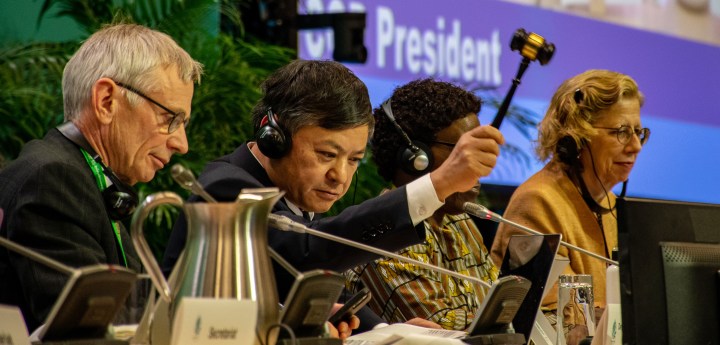
At around 3.30am on Monday, 196 countries adopted the Kunming-Montreal Global Biodiversity Framework committing the world to halt and reverse biodiversity loss by 2030, a global goal hailed as the equivalent of the totemic 1.5°C climate target.
In the eighth hour of the United Nations plenary for the adoption of the Kunming-Montreal Global Biodiversity Framework at the UN Biodiversity Conference, COP15, in the early hours of Tuesday morning, the executive secretary of the UN Convention on Biological Diversity, Elizabeth Maruma Mrema, from Tanzania, quoted Nelson Mandela: “It always seems impossible, until it is done.”
This is something the room full of delegates Mrema was addressing — some resting their heads on their hands, struggling to keep their eyes open, while some seemed fast asleep after two very late nights in a row and a gruelling two weeks of negotiations — could relate to.
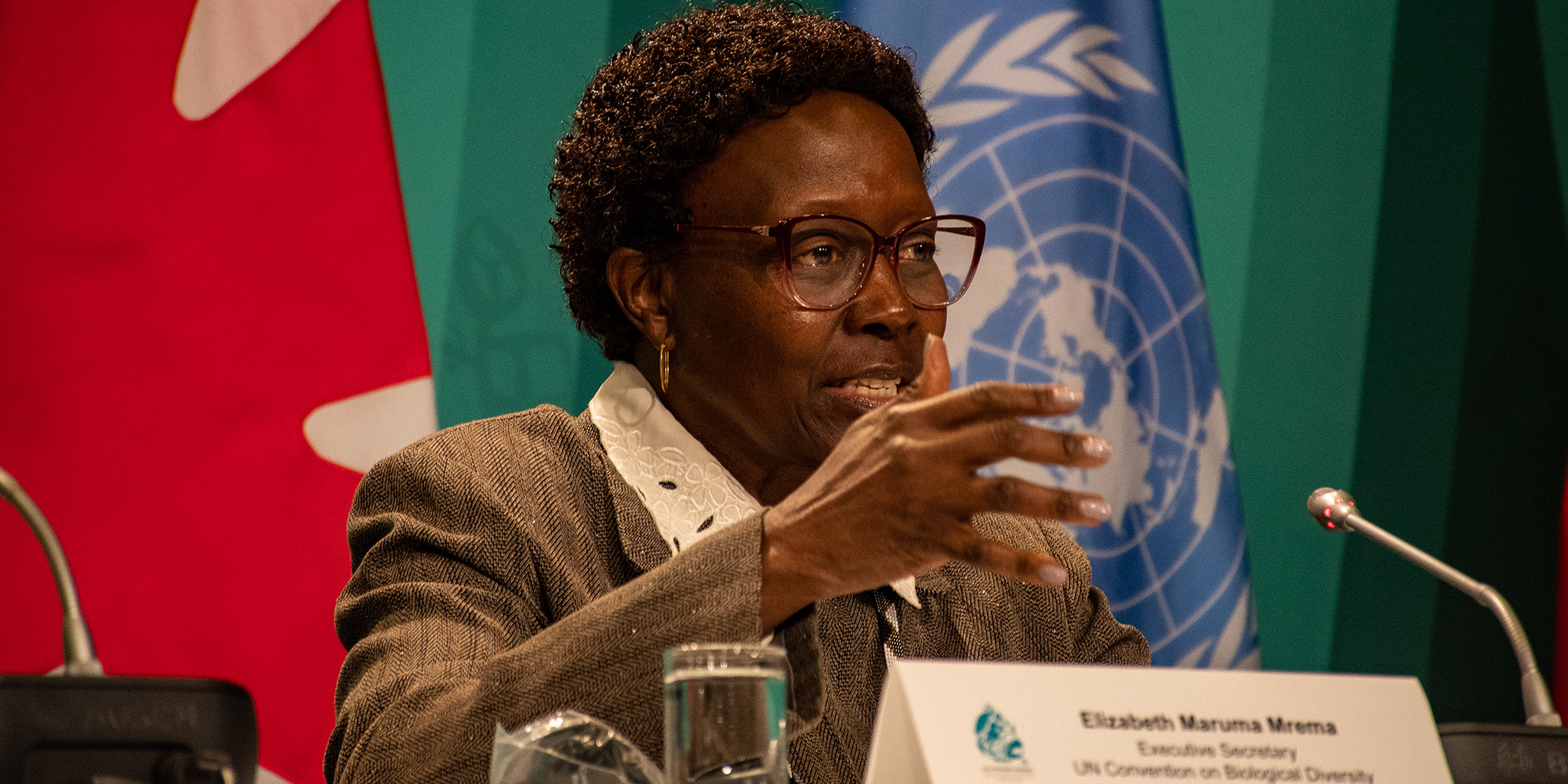
Elizabeth Maruma Mrema, Executive Secretary of the UN Convention on Biological Diversity, during a press conference at the UN Biodiversity Conference, COP15, Palais des Congrès, Montreal, Canada. (Photo: Julia Evans)
The United Nations Convention on Biological Diversity (CBD) is one of three international environmental treaties that was first established at the Earth Summit in Rio de Janeiro in 1992.
Since then, the 196 nations party to that convention have met 15 times with the three main aims of promoting the conservation of biological diversity, sustainable use, and fair and equitable sharing of the benefits of genetic resources.
But this meeting, the 15th Conference of the Parties (COP15), was the most significant.
The last time parties to this convention met was four years ago — the biodiversity convention is meant to meet every two years, but the meeting in 2020 was delayed because of the pandemic.
So, it’s been a long road, with five engagements, both in person and online, to get here, and negotiations over the past two weeks have not been any easier — as reflected in Monday/Tuesday’s eight-hour plenary to confirm the framework first adopted in the early hours of Monday morning, 19 December.
In a truly historic moment, at around 3.30am on Monday, 196 countries that are part of the CBD, under the presidency of China, adopted the Kunming-Montreal Global Biodiversity Framework committing the world to halt and reverse biodiversity loss by 2030, a global goal hailed as the equivalent of the 1.5°C climate target.
Importantly, despite this conference receiving relatively little media attention and poor political attendance compared with the climate conference in Egypt last month, climate goals cannot be achieved without protecting and restoring nature — nature loss is one-third of the climate problem but nature can contribute to one-third of the solution.
Because of the delays, there are only eight years left to achieve many of the 23 ambitious targets set for 2030.

Camila Isabel Zepeda Lizama, part of the delegation for Mexico, after the Global Biodiversity Framework was adopted in the early hours of 19 December 2022, Montreal, Canada. (Photo: UN Biodiversity)
As Camila Isabel Zepeda Lizama, head of the delegation from Mexico, said to parties after Democratic Republic of the Congo objected to the framework just before it was adopted on Monday: “A perfect text will never exist — the perfect is the enemy of the good.”
She said a framework needed to be adopted so that implementation of the targets on the ground could start as soon as possible.
“The world is watching us and the spotlight has to be on developed nations and their ability to respect this agreement and to engage quickly,” said Lee White, Gabon’s Minister of Water, Forests, the Sea and Environment, after the framework was adopted.
30% of land and water protected
The headline target — hailed as ambitious by some and not enough by others — is to effectively conserve at least 30% of the world’s lands, freshwater and oceans, while respecting the rights and contribution of indigenous peoples and local communities.
“The ‘30×30’ target marks the largest land and ocean conservation commitment in history,” said Brian O’Donnell, director of the Campaign for Nature.
“It will have major positive impacts for wildlife, for addressing climate change, and for securing the services that nature provides to people, including clean water and pollination for crops.”
Currently, 17% and 10% of the world’s terrestrial and marine areas, respectively, are under protection.
In South Africa, according to the Department of Forestry, Fisheries and Environment, 16.65% of South Africa’s 121 million hectares of land are under conservation estate (just over 20 million hectares) and about 14.5% of South Africa’s waters are protected.
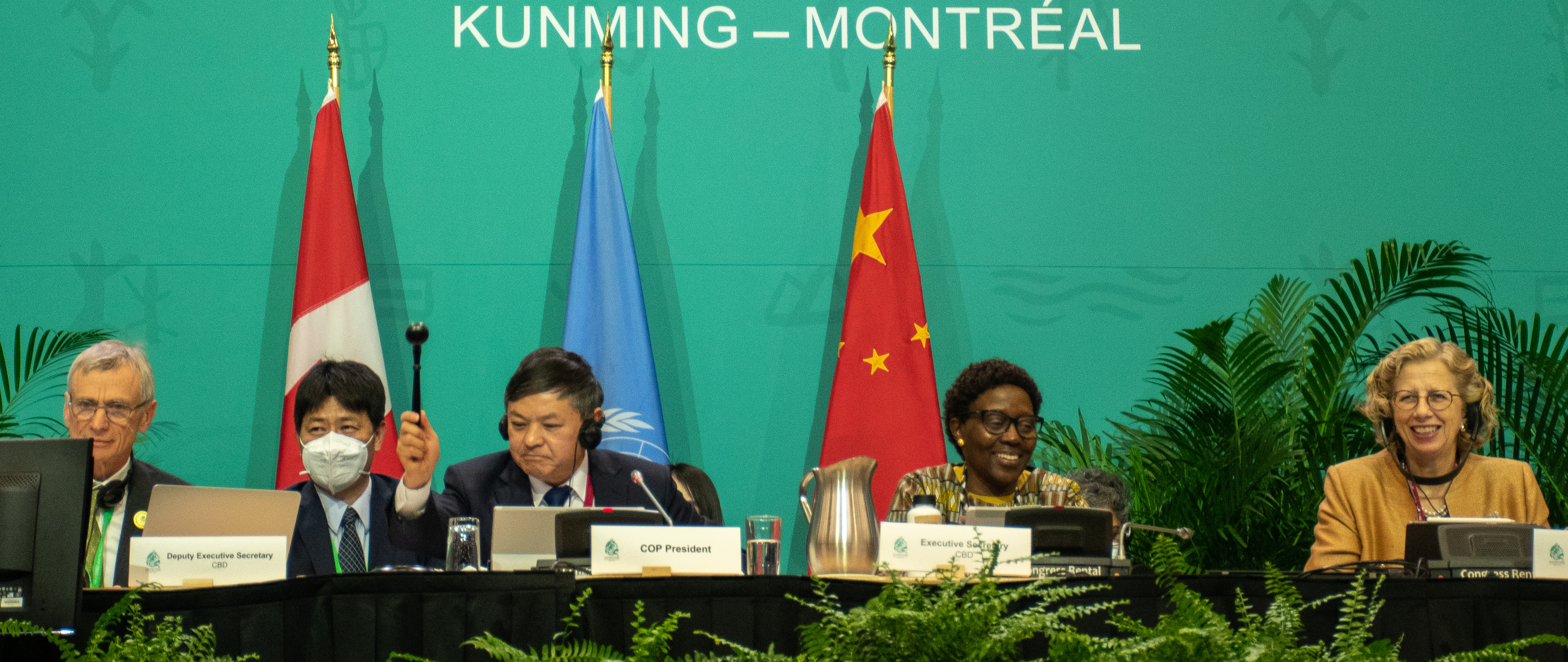
From left: David Cooper, CBD Deputy Executive Secretary; Minister of Ecology and Environment, China, Xia Yingxian; COP15 President Huang Runqi; Elizabeth Maruma Mrema, CBD Executive Secretary; and Inger Andersen, Executive Director of the UN Environment Programme, at COP15, in Montreal, Canada, 19 December, 2022. (Photo: Julia Evans)
Finance
Like many developing nations going into these talks, the South African delegation emphasised that the targets in the Global Biodiversity framework would only be viable if there were resources to make the implementation possible.
Analysts estimate the funding needed to implement the framework is $1-trillion a year.
The final text used a smaller number, of $700-billion a year, made up of phasing out or reforming harmful subsidies of at least $500-billion a year by 2030, and mobilising at least $200-billion a year of financial flow for biodiversity by 2030, in domestic and international biodiversity-related funding from all sources, public and private.
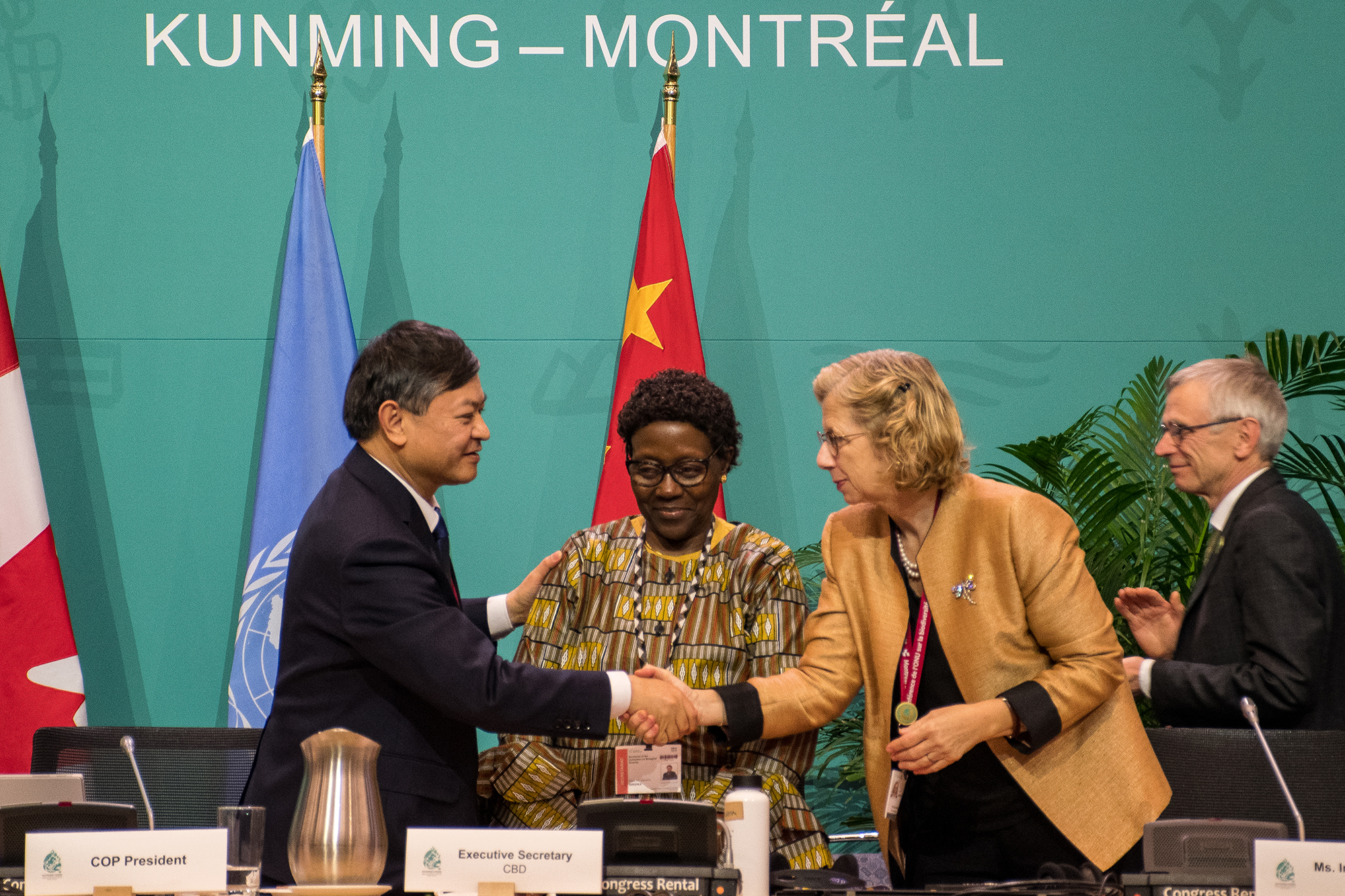
COP15 President Huang Runqiu shakes hands with Inger Andersen, Executive Director of the UN Environment Programme. Pictured between them is Elizabeth Maruma Mrema, CBD Executive Secretary, at the end of COP15 and after the Kunming-Montreal Global Biodiversity Framework had been agreed upon in Montreal, Canada. (Photo: Julia Evans)
The latter will include at least $20-billion a year to be channelled to developing countries from developed countries by 2025 and $30-billion a year by 2030.
During this conference, the African delegation group and like-minded biodiverse countries like Brazil called for the establishment of a global biodiversity fund, separate from the UN’s existing financial mechanisms (the Global Environmental Facility) that funds all three Rio Conventions (climate, desertification and biodiversity).
The logic was, that like the other two Rio Conventions (for climate and desertification), biodiversity needed its own separate fund too.
Visit Daily Maverick’s home page for more news, analysis and investigations
Resource Mobilisation was one of the six package deals agreed upon, which created a dedicated fund for biodiversity — the Global Biodiversity Framework Fund (GBF Fund) — which will be set up in 2023. But this fund is still under the UN’s existing Global Environment Facility (GEF).
It will have its own governing body to support the implementation of the GBF Fund, and countries will explore further options, including the possibility of a standalone fund, in the coming years.
The decision also includes a number of important elements on access, adequacy, predictability, equitable governance and financing from all sources — meaning it might be easier for private financiers to donate to this fund.
“Please be assured of my commitment to work with the GEF Council, countries and partners, to operationalise the decision and to address these important elements in a timely manner,” said Carlos Manuel Rodriguez, CEO and chairperson of the GEF
David Obura, a biodiversity scientist from Kenya who was involved with the input of science to the targets for the biodiversity framework, told Daily Maverick right before the final framework was adopted: “We need 100 times more money spent on maintaining natural stems around the world.”

Steven Guilbeault (left), Canadian Minister of Environment and Climate Change, and Rigobert Ntep (second from left), Minister of Environment for Cameroon, and other delegates after the Global Biodiversity Framework was adopted in the early hours of 19 December 2022 in Montreal, Canada. (Photo: UN Biodiversity)
Obura said this amount can’t just come from the GEF, but setting up a new biodiversity fund might not necessarily be more efficient either.
“But we need many more large sources, and we need business to pay for the cost of doing business, which it’s not doing. So, it’s not just about having a fund returned because governments are doing it government to government — it needs to be built into the cost of doing business.”
Obura added that while many of the negotiators were very knowledgeable, there might be other things that they were negotiating on, the basis of which affected their final decision.
“The science doesn’t necessarily inform the final formulation … countries don’t want to be held accountable … it costs money, it costs effort.”
Obura explained that developed countries were reticent about committing to the amount of resources needed, and developing countries were criticised for not meeting the targets and for not implementing up to certain standards.
Digital sequence information
Digital sequence information (DSI) in genetic resources has been a hot topic at COP15. It deals with the genetic information of an organism, such as the desirable traits of a plant that can be synthetically replicated.
It is used for many commercial and non-commercial applications, including pharmaceutical product development, improved crop breeding, taxonomy and the monitoring of invasive species.
How this genetic information is accessed by researchers, and how countries of origin can benefit from it, is a very contentious issue. Once the genomic sequence data and other related digital data are in an international database, you no longer need to go back to a country to get an organism sample.
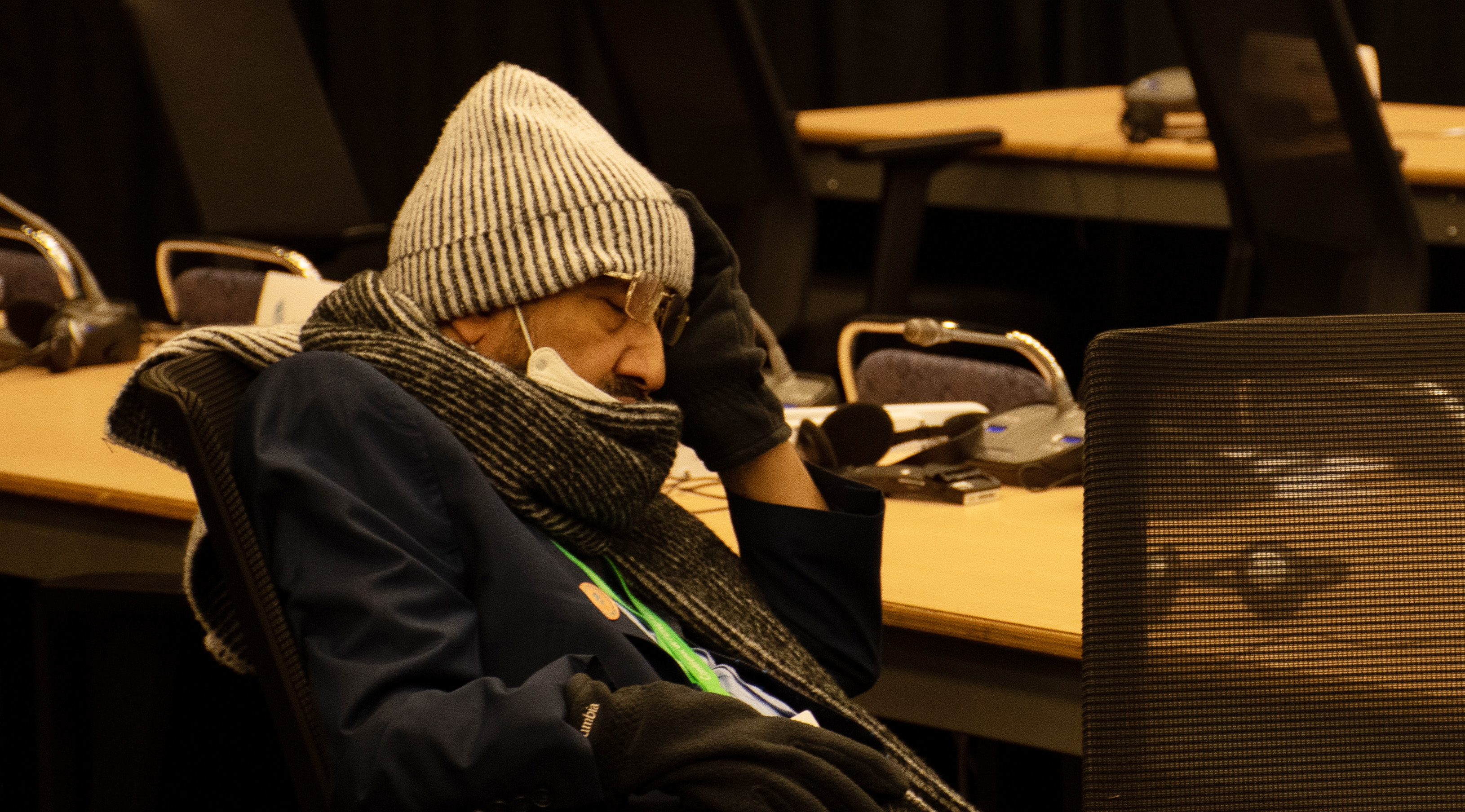
A delegate falls asleep during the eight-hour plenary to adopt the Kunming-Montreal Global Biodiversity Framework at COP15. (Photo: Julia Evans)
Going into COP15, there were multilateral mechanisms on access and benefit sharing (ABS), under the existing Nagoya Protocol, which limits benefit sharing.
By the end of negotiations, COP15 delegates agreed to establish within the GBF a multilateral fund for the equitable sharing of benefits between providers and users of DSI, to be finalised at COP16 in Turkey in 2024.
Jessica da Silva from the South African National Biodiversity Institute (Sanbi), who worked on DSI at COP15, told Daily Maverick that while a multilateral solution seemed to be holding for DSI, with fairness woven throughout, “The proof will be in the implementation and in the details of how the flow of finances will come to pass, and what specifically will and will not be permitted with benefit sharing.”
Not repeating the same mistake twice
Last time, things did not go to plan.
In 2010, parties of CBD created 20 Aichi Biodiversity Targets, a 10-year plan for conserving biodiversity — but none of those targets was fully achieved by the deadline.
Twelve years later, the draft of the global biodiversity framework ominously warned: “Without such action, there will be a further acceleration in the global rate of species extinction … already at least tens to hundreds of times higher than it has averaged over the past 10 million years.”
Shonisani Munzhedzi, CEO of Sanbi and co-chair of the resource mobilisation contact group at COP15, told DM at the start of the conference: “There’s an acknowledgement that the previous strategic plan didn’t work,” explaining that a report on its failures indicated it was mainly down to implementation.
To not repeat the same mistakes, delegates went into these talks with the aim of making the targets ambitious enough to halt the devastating loss of biodiversity, but to be measurable and have the means of implementation so it actually happens.
“What we’re calling for is the means of implementation that come in the form of three things – finance, capacity building and technological support – that must be commensurate with or match their ambition,” explained Munzhedzi.
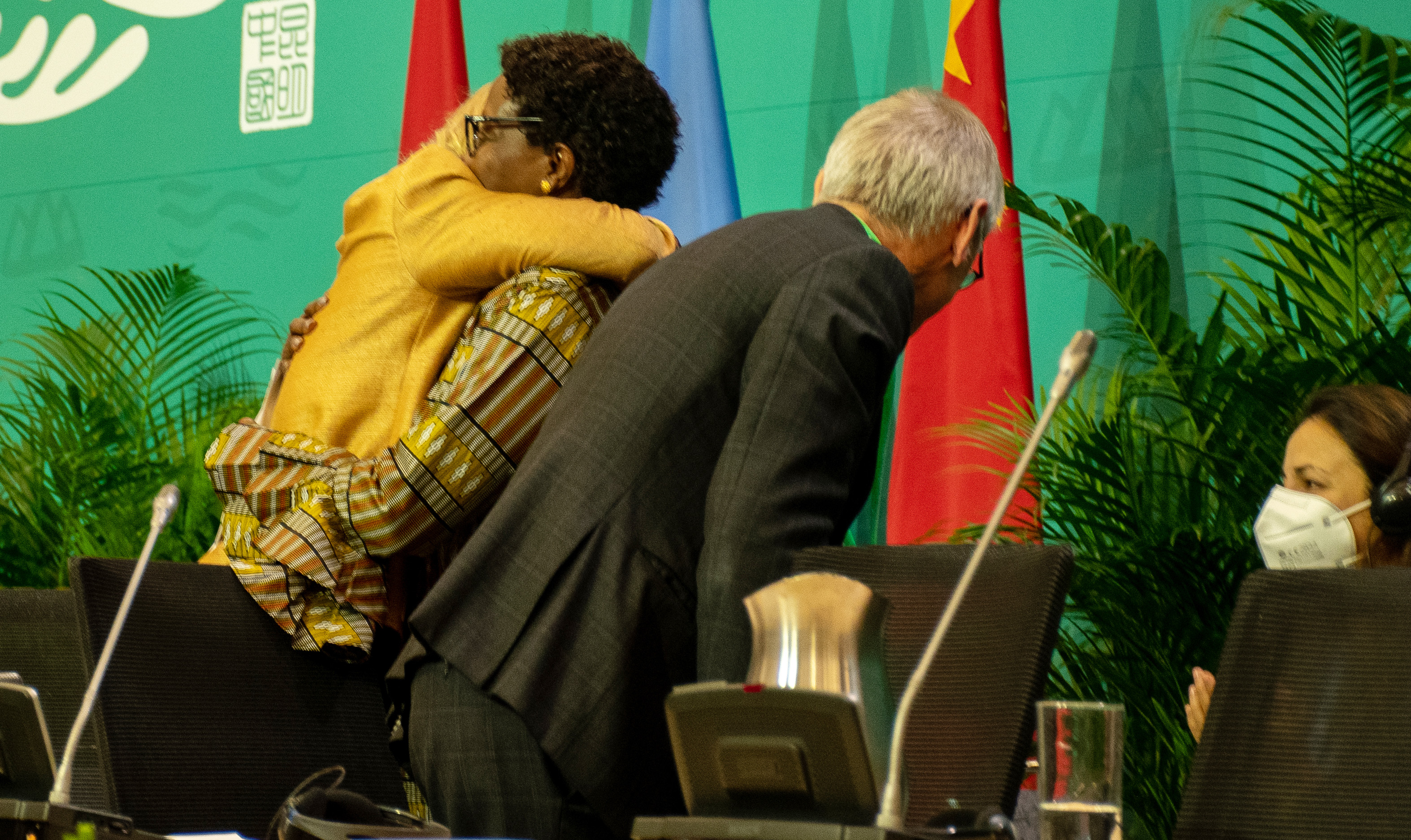
Inger Andersen, Executive Director of the UN Environment Programme, embraces Elizabeth Maruma Mrema, CBD Executive Secretary, at the end of the final plenary to adopt the Kunming-Montreal Global Biodiversity Framework at COP15, 19 December, 2022. (Photo: Julia Evans)
Accountability
This framework is different as it has robust government plans and business accountability at its centre, where all of the economy is involved.
Implementation & Accountability is one part of the framework, which requires large and transnational companies and financial institutions to monitor, assess and transparently disclose their risks, dependencies and impacts on biodiversity through their operations, supply and value chains, and portfolios.
The agreement also obliges countries to monitor and report every five years or less on a large set of “headline” and other indicators related to progress against the GBF’s goals and targets, such as the percentage of land and seas effectively conserved, and the number of companies disclosing their impacts and dependencies on biodiversity.
The CBD will combine national information submitted by late February 2026 and late June 2029 into global trends and progress reports.
However, Marco Lambertini, the director-general of WWF International, said the final text “lacks a mandatory ratcheting mechanism that will hold governments accountable to increase action if targets are not met”.
“We must now see immediate implementation of this agreement, no excuses, no delays — nature and all of us who rely on it for our livelihoods, economies and wellbeing have waited long enough; it’s time for nature to thrive again.
“Governments have chosen the right side of history in Montreal, but history will judge all of us if we don’t deliver on the promise made today.” DM/OBP
This story was produced as part of Internews’ Earth Journalism Network Fellowship Programme to the CBD COP15 Summit in Montreal, Canada.






















 Become an Insider
Become an Insider
Comments - Please login in order to comment.